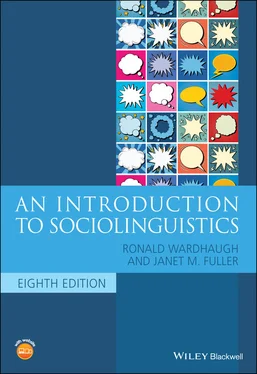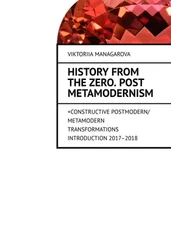Another way of viewing how an individual relates to other individuals in society is to ask what social networkshe or she participates in. That is, how and on what occasions does a specific individual A interact now with B, then with C, and then again with D? How intensive are the various relationships: does A interact more frequently with B than with C or D? How extensive is A’s relationship with B in the sense of how many other individuals interact with both A and B in whatever activity brings them together? In a situation in which A, B, C, D, and E are linked in a network, do they all have links to each other or are B, C, D, and E only linked to A but not each other? How people in a social network are linked to each other is one way of viewing social groups as defined by the kinds, frequency, and constellation of social interactions.
Research on social networks in sociolinguistics has proliferated in the last few decades, but is most directly linked to Milroy (1980, 1987; Milroy and Llamas 2013). This work adapted sociological social network theory to sociolinguistics and showed how it could be used in the study of language. Different types of social networks contribute to different pattern of language variation and change (a topic which will be addressed in more detail in chapter 5). You are said to be involved in a dense social networkif the people you know and interact with also know and interact with one another. If they do not do so, the social network is a looseone. You are also said to be involved in a multiplex social networkif the people within it are tied together in more than one way, that is, not just through work but also through other social activities. People who go to school together, marry each other’s siblings, and work and play together participate in dense multiplex networks. (To see diagrams of these different types of networks, see the page for social network theory on English Language and Linguistics Online , http://www.ello.uos.de/).
In England multiplex social networks are said to be found at the extremes of the social‐class structure. Such networks indicate strong social cohesion, produce feelings of solidarity, and encourage individuals to identify with others within the network. In terms of language use, this means that distinct features are often preserved. On the other hand, middle‐class networks are likely to be loose and simplex; therefore, social cohesion is reduced and there are weaker feelings of solidarity and identity. Within such networks linguistic norms are less well enforced (Milroy 1980).
The social networks of particular individuals are not fixed; they can change, just as the ways in which people speak can change over their lifetimes. People also belong to different networks of different strengths. The availability of computers, smart phones, and other devices has produced entirely new types of social networking which many people now use extensively, and there is now a body of research which looks at how these virtual networks function as speech communities (see Androutsopoulos 2006; Aitchison and Lewis 2003; and Akkaya 2014 for overviews of this research).
Much linguistic behavior seems explicable in terms of network structure and we will see in chapter 5how valuable the concept of ‘social network’ is when we consider matters of language variation and change (see Milroy and Llamas 2013 for additional details). One of the advantages of a social network approach to the study of social groups is that instead of dealing with abstract categories, it looks specifically at who interacts with whom, and how. In this way it is similar to community of practice research. As noted by Milroy and Gordon (2008, 119), these two methods differ primarily in method and focus: social network approaches look at the ties that foster innovation or the maintenance of linguistic norms, while community of practice research examines how these features are used within group interaction. We will return to this topic and to a discussion of studies employing these frameworks in chapters 5and 6as we continue to develop our ideas on language variation and sociolinguistic methodologies.
Exploration 3.2 Social Networks
Draw a quick version of your own social network – yourself and ten close friends or family members (don’t overthink this; this is not an actual social network analysis, merely an exercise to get us thinking about how these relationships work in our lives!). Use solid lines for strong ties, dotted lines for weak ties, and single and double lines for those you have infrequent versus frequent contact with.
How would you describe your social network – loose, dense, multiplex or simplex? Looking at your own network, what predictions would you make about who you share the most linguistic features with, and why? (And do you think this is accurate?)
Many of the ideas and issues involved in the study of speech communities, communities of practice, and social networks have been incorporated into the scholarship on language and identity. In chapter 1, we introduced the concept of identity as ‘the linguistic construction of membership in one or more social groups or categories’ (Kroskrity 2000, 111). Much of the literature on language and identity is based on the post‐structuralist idea that social practices (such as language use) produce and reproduce the social world, including speaker identities (Carter 2013). Thus, as Foucault (1980) has argued, the self is not fixed, but is something which is positioned and repositioned through discourse.
A framework for the study of language and identity has been presented by Bucholtz and Hall (2005). They spell out five key aspects of the relationship of language and identity, which we explain below with relevant examples.
(1) Identity is not something you have , it is something you do . Although we often think of identities as some sort of ‘real self,’ within social theory this is not what is meant by identity. Instead, identities are constructed through social behavior. Thus, sexual identity is not seen as a fixed attribute of a person, but performed through references to partners, self‐labeling (e.g., ‘gay’ or ‘straight’), or indirect indices which indicate sexuality within a particular culture (e.g., rainbows as a symbol of LGBTQ identification).
(2) There are multiple levels of identity. These include identification with enduring social categories such as ‘race’ but also situational roles such as ‘teacher’ and interactional stances of similarity and difference. So an African American teacher in a majority White school may see herself as a member of a community of practice with the other teachers at the elementary school where she works, but may also construct her identity as different from these colleagues in a discussion of race or White privilege.
(3) Various linguistic means can be used to construct identities. These include such means as explicit naming (e.g., ‘I’m Mexican’; see Shenk 2007), or the use of a particular language to index an identity (e.g., Spanish to index a Mexican or Latinx identity), along with many others. We will discuss this further in chapter 7.
(4) Identities are constructed in relationship to other people. For example, an individual’s identity as a woman, with a focus on the physical attributes of womanhood, may be brought to the forefront in one interaction (e.g., in a discussion about mammograms), but in another situation this identity may be further defined with regard to professional identity (e.g., while participating in a women’s mentoring organization at work). In an online interaction, the gender identity of this same person may be completely irrelevant and unknown to the other participants in the dialogue. (See chapter 7for further discussion of this aspect of identity construction through discourse.)
Читать дальше




![Andrew Radford - Linguistics An Introduction [Second Edition]](/books/397851/andrew-radford-linguistics-an-introduction-second-thumb.webp)







